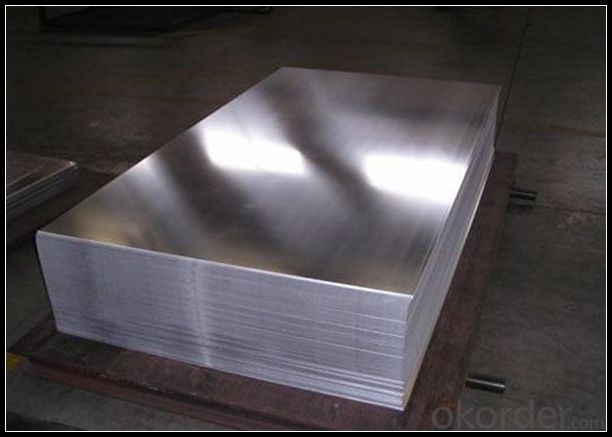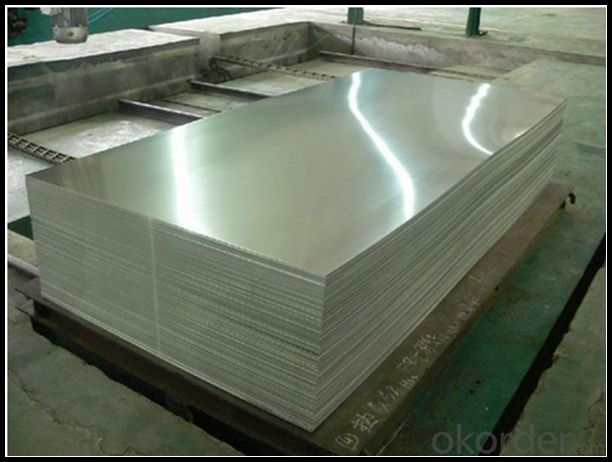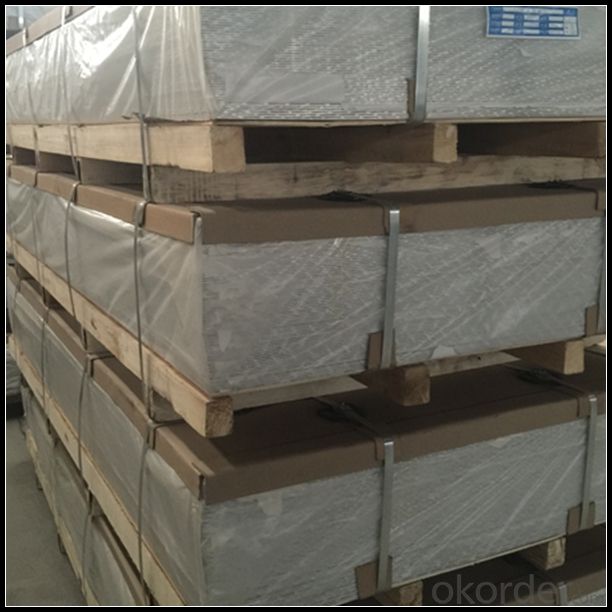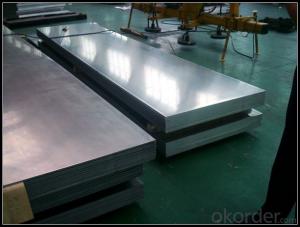Mill Finished Aluminium Sheet for Building Roofing
- Loading Port:
- Shanghai
- Payment Terms:
- TT OR LC
- Min Order Qty:
- 5 m.t.
- Supply Capability:
- 10000 m.t./month
OKorder Service Pledge
OKorder Financial Service
You Might Also Like
Item specifice
1. Specification of Mill Finished Aluminium Sheet for Building Roofing
ALLOY | AA1050 AA1060 AA1070 AA1100 ETC AA3003 AA3004 AA3005 AA3104 AA3105 ETC AA5005 AA5052 AA5083 AA5754 ETC AA8011 AA8006 AA8079 ETC |
TEMPER | H14,H16,H18,H22,H24,H26,H32,O/F |
THICKNESS | ≥0.2MM |
WIDTH | 30mm-2100mm |
COIL WGT | 2Mt - 3Mt |
COIL ID | φ508mm,φ610mm |
SURFACE | PE Protecting film |
STANDARD | GB/T 3880-2006 |
2. Application of Mill Finished Aluminium Sheet for Building Roofing
(1).Interior: wall cladding, ceilings, bathrooms, kitchens and balconies, shutters, doors...
(2).Exterior: wall cladding, facades, roofing, canopies, tunnels,column covers , renovations...
(3).Advertisement: display platforms, signboards, fascia, shop fronts...
3. Feature of Mill Finished Aluminium Sheet for Building Roofing
Surfact Quality :
Be free from Oil Stain, Dent, Inclusion, Scratches, Stain, Oxide Dicoloration, Breaks, Corrosion, Roll Marks, Dirt Streaks and other defect which will interfere with use,
Mechenical Property:
Chemical Composite and Mechanical Property
4. Certificate:
SGS and ROHS(if client request, paid by client), MTC(plant provided), Certificate of Origin(FORM A, FORM E, CO), Bureau Veritas and SGS (if client request, paid by client), CIQS certificate
5. Image of Mill Finished Aluminium Sheet for Building Roofing



6. Package and shipping of Mill Finished Aluminium Sheet for Building Roofing
First, plastic cloth with drying agent inside; Second, Pearl Wool ; Third, wooden cases with dry agent , fumigation wooden pallets, aluminum surface could cover blue PVC film
7. FAQ
1) What is the delivery time?
Dpends on actual order, around 20 to 35 days
2)What is the QC system:
We have QC staff of 20 persons and advanced equipment, each production is with MTC traced from Aluminum ingot lot.
3) What market do you mainly sell to?
Australia, America, Asia, Middle East, Western Europe, Africa etc
- Q:Can 101 aluminum sheets be anodized in different colors?
- Yes, 101 aluminum sheets can be anodized in different colors. Anodizing is a process that involves creating an oxide layer on the surface of aluminum, which can be dyed to achieve various colors. The number of sheets, in this case 101, does not restrict the ability to anodize them in different colors. Each sheet can be individually anodized and dyed to create a unique and desired color. Anodizing is a versatile process that allows for customization and color variation, making it possible to achieve different shades and hues on each aluminum sheet.
- Q:How do you prevent oxidation of aluminum sheets?
- To prevent oxidation of aluminum sheets, several methods can be employed. One common approach is to apply a protective coating or finish on the surface of the aluminum sheets. This coating acts as a barrier between the aluminum and the external environment, preventing the metal from reacting with oxygen and forming an oxide layer. There are various types of coatings available for this purpose, including anodizing, painting, and powder coating. Anodizing is a process that involves creating a controlled oxide layer on the surface of the aluminum through electrolysis. This oxide layer is highly resistant to corrosion and provides excellent protection against oxidation. Painting and powder coating involve applying a layer of paint or powdered polymer onto the aluminum surface. These coatings form a physical barrier that shields the metal from oxygen and moisture. Another effective way to prevent oxidation is by using aluminum alloys that have enhanced corrosion resistance. These alloys are specifically designed to have a higher resistance to oxidation and can withstand exposure to harsh environments without forming a significant oxide layer. In addition to coatings and alloy selection, proper storage and handling practices are crucial to prevent oxidation. Aluminum sheets should be stored in a clean, dry, and well-ventilated area to minimize exposure to moisture and corrosive elements. Any contact with acidic or alkaline substances should be avoided, as they can accelerate the oxidation process. Regular cleaning and maintenance of aluminum sheets also help in preventing oxidation by removing any contaminants that could promote corrosion. Overall, preventing oxidation of aluminum sheets involves a combination of protective coatings, appropriate alloy selection, and proper storage and handling practices. By implementing these measures, the lifespan and durability of aluminum sheets can be significantly improved.
- Q:i want to a material which is similar in properties like aluminium which has similar casting properties and easily available.
- It depends on what properties you are interested in. If you want specific answers, you need to ask specific questions. The previous answerers are not very well informed... There are, in fact, many excellent Al based casting alloys. And... cast alloys of brass, pot metal, lead, etc are not very similar to Al (but, again, it depends on specifically what properties you want). Consult your friendly neighborhood metallurgist but think about exactly what characteristics you need to have. The more completely you can define your requirements, the better someone can advise you on the pros and cons of different material selections.
- Q:why is it gd and what are common aluminium compounds??? thx
- It's quite expensive to make aluminum, whereas it's quite cheap to melt it down and reuse it.
- Q:Can aluminum sheets be used for lithographic printing?
- Yes, aluminum sheets can be used for lithographic printing. Lithographic printing, also known as offset printing, is a popular printing technique that involves transferring an image from a plate onto a rubber blanket and then onto the printing surface. Aluminum sheets are commonly used as the base material for lithographic plates due to their excellent durability, lightweight nature, and ability to hold fine details. The aluminum sheets used for lithographic printing are typically coated with a photosensitive emulsion, which allows the image to be transferred onto the printing surface with precision and accuracy. This makes aluminum sheets an ideal choice for lithographic printing, especially for high-quality and large-scale printing projects.
- Q:Can aluminum sheet be used for electronic components?
- Yes, aluminum sheet can be used for electronic components. Aluminum is a versatile material that offers several advantages for electronic applications. It is lightweight, has excellent thermal conductivity, and is resistant to corrosion. These properties make it suitable for a wide range of electronic components, such as heat sinks, enclosures, connectors, and printed circuit boards (PCBs). Aluminum sheets can be easily machined, formed, and welded, allowing for efficient manufacturing processes. Additionally, aluminum is a cost-effective material compared to alternatives like copper or steel. However, it is important to note that aluminum is not suitable for all electronic components, especially those that require high electrical conductivity or magnetic shielding.
- Q:Are aluminum sheets suitable for automotive suspension components?
- Automotive suspension components can indeed be made from aluminum sheets, which offer numerous advantages. Firstly, aluminum sheets are much lighter than traditional steel components. This reduction in weight can lead to improved fuel efficiency and overall vehicle performance. By reducing the weight of suspension components, the vehicle's handling, acceleration, and braking can be enhanced, resulting in a smoother and more responsive ride. Secondly, aluminum possesses an excellent strength-to-weight ratio. This means that it can provide the necessary structural integrity and support for suspension components while still being lightweight. It has high tensile strength and stiffness, enabling it to withstand the stresses and forces exerted on suspension components during normal driving conditions. Furthermore, aluminum is highly resistant to corrosion, which is especially beneficial for automotive suspension components that are exposed to various environmental conditions. This corrosion resistance ensures the longevity and durability of the suspension system, reducing the need for frequent repairs or replacements. Moreover, aluminum is easily machinable, allowing for the creation of complex and intricate designs that can optimize suspension performance. Its flexibility in shaping and forming enables manufacturers to create suspension components with specific geometries and characteristics to meet the desired performance requirements. In conclusion, aluminum sheets are an excellent choice for automotive suspension components due to their lightweight nature, high strength-to-weight ratio, corrosion resistance, and machinability. These properties make aluminum a preferred material for suspension components, resulting in improved vehicle performance, fuel efficiency, and overall durability.
- Q:What are the different methods of cutting aluminum sheets?
- There are several methods that can be used to cut aluminum sheets, depending on the specific requirements and the thickness of the material. Some of the most commonly used methods include: 1. Shearing: This method involves using a shearing machine to cut straight lines in the aluminum sheet. The machine applies a force to a blade, which then cuts through the material. Shearing is a quick and efficient method for cutting aluminum sheets, especially for thinner gauges. 2. Sawing: Sawing is another common method used to cut aluminum sheets. It involves using a circular saw or a bandsaw with a special blade designed for cutting metal. This method is ideal for thicker aluminum sheets, as it allows for more precision and controlled cuts. 3. Laser cutting: Laser cutting is a highly precise and efficient method for cutting aluminum sheets. It uses a concentrated beam of light to melt and vaporize the material, creating a clean and smooth cut. Laser cutting is particularly useful for intricate designs or complex shapes. 4. Waterjet cutting: Waterjet cutting involves using a high-pressure stream of water mixed with abrasive particles to cut through aluminum sheets. This method is suitable for various thicknesses and can achieve precise cuts without generating heat. Waterjet cutting is often used for thicker aluminum sheets or when high precision is required. 5. Plasma cutting: Plasma cutting uses a high-temperature plasma torch to melt and cut through aluminum sheets. The torch generates an electric arc that ionizes the gas, creating a plasma state. This method is versatile and can cut through different thicknesses of aluminum sheets, but it may result in rougher edges compared to laser or waterjet cutting. It is important to consider the specific requirements of the project, such as the desired cut quality, speed, and complexity, when choosing the most appropriate method for cutting aluminum sheets.
- Q:Is aluminum sheet corrosion-resistant?
- Yes, aluminum sheet is corrosion-resistant due to its natural oxide layer that forms on its surface, protecting it from corrosion and making it suitable for various applications in industries such as construction, automotive, and aerospace.
- Q:How do aluminum sheets compare to steel sheets in terms of strength?
- Strength differs between aluminum sheets and steel sheets. Steel is generally stronger than aluminum due to its higher tensile strength, allowing it to withstand greater forces without breaking or deforming. Steel sheets find common use in construction, automotive manufacturing, and aerospace, where high strength and durability are necessary. Conversely, aluminum sheets strike a good balance between strength and weight. Although not as strong as steel, aluminum is significantly lighter, making it advantageous in applications prioritizing weight reduction, such as aircraft and vehicle manufacturing. Additionally, aluminum sheets exhibit excellent corrosion resistance, making them suitable for outdoor or marine environments. Ultimately, the choice between aluminum and steel sheets hinges on the specific requirements of the application, considering factors like strength, weight, durability, and corrosion resistance.
1. Manufacturer Overview |
|
|---|---|
| Location | |
| Year Established | |
| Annual Output Value | |
| Main Markets | |
| Company Certifications | |
2. Manufacturer Certificates |
|
|---|---|
| a) Certification Name | |
| Range | |
| Reference | |
| Validity Period | |
3. Manufacturer Capability |
|
|---|---|
| a)Trade Capacity | |
| Nearest Port | |
| Export Percentage | |
| No.of Employees in Trade Department | |
| Language Spoken: | |
| b)Factory Information | |
| Factory Size: | |
| No. of Production Lines | |
| Contract Manufacturing | |
| Product Price Range | |
Send your message to us
Mill Finished Aluminium Sheet for Building Roofing
- Loading Port:
- Shanghai
- Payment Terms:
- TT OR LC
- Min Order Qty:
- 5 m.t.
- Supply Capability:
- 10000 m.t./month
OKorder Service Pledge
OKorder Financial Service
Similar products
New products
Hot products
Related keywords



























